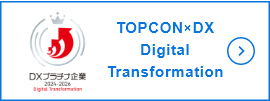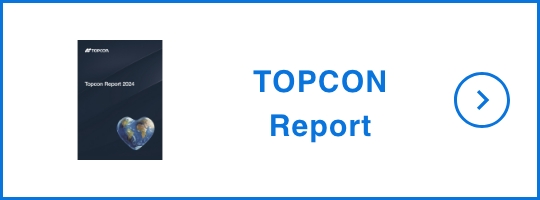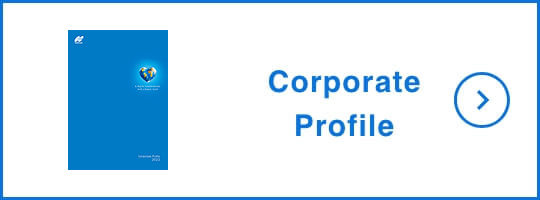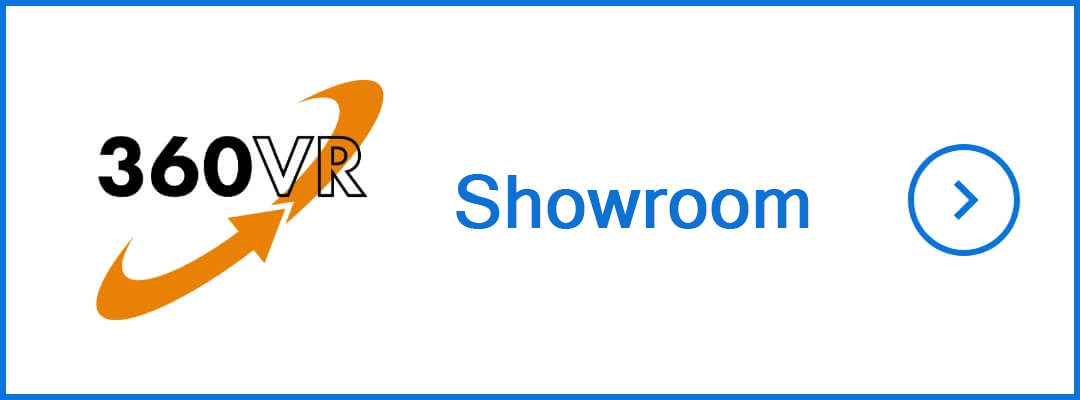Disclosure based on the TCFD recommendations
Governance
Topcon has built a governance structure with the view that initiatives for sustainability, including response to climate change, are a key management issue.
Risk Management
We conduct monitoring and management with the view that climate change-related risks are part of business risk. For details of governance and risk management related to climate change, please refer to “Sustainability Governance” on pages 44 and 48 of the Topcon Report 2024.
Strategy
We conducted scenario analyses for our businesses to identify the risks and opportunities related to climate change that are expected to have a major impact in 2030. In those scenario analyses, based on the Task Force on Climate-related Financial Disclosures (TCFD), we envisaged scenarios in which the global temperature rise in 2100 would be 1.5°C and 4°C higher than pre-industrial levels.
The 1.5°C scenario assumes satisfactory progress in the global implementation of measures against climate change, the introduction of climate policies (introduction of carbon tax, tightening of decarbonization regulations,etc.), the transition of markets and technologies to low-carbon models (introduction of energy conservation measures/renewable energy sources, growing need for carbon neutrality, etc.), as well as changes in reputation.
The 4°C scenario assumes little progress in the implementation of measures against climate change and resultant changes such as a more serious impact of climate change, increased severity of extreme weather events (larger-scale typhoons, hurricanes, etc.), rising temperatures, and increased incidence of extreme weather events.
We also conducted materiality assessments and financial impact assessments with reference to the scenarios disclosed by research institutions shown in the table below.
We have summarized risks and opportunities identified through the scenario analyses and considered countermeasures to minimize the risks and maximize the opportunities.
Temperature rise | Transition scenarios | Physical scenarios |
|---|---|---|
IEA(International Energy Agency) “World Energy Outlook 2023” | IPCC(Intergovernmental Panel on Climate Change) “AR5(Fifth Assessment Report)” | |
| 4℃ | The Stated Policies Scenario(STEPS) | Representative Concentration Pathways(RCP)8.5・6.0 |
| 1.5℃ | Net Zero Emissions by 2050 Scenario (NZE) | RCP1.9 |
Steps to develop TCFD strategy
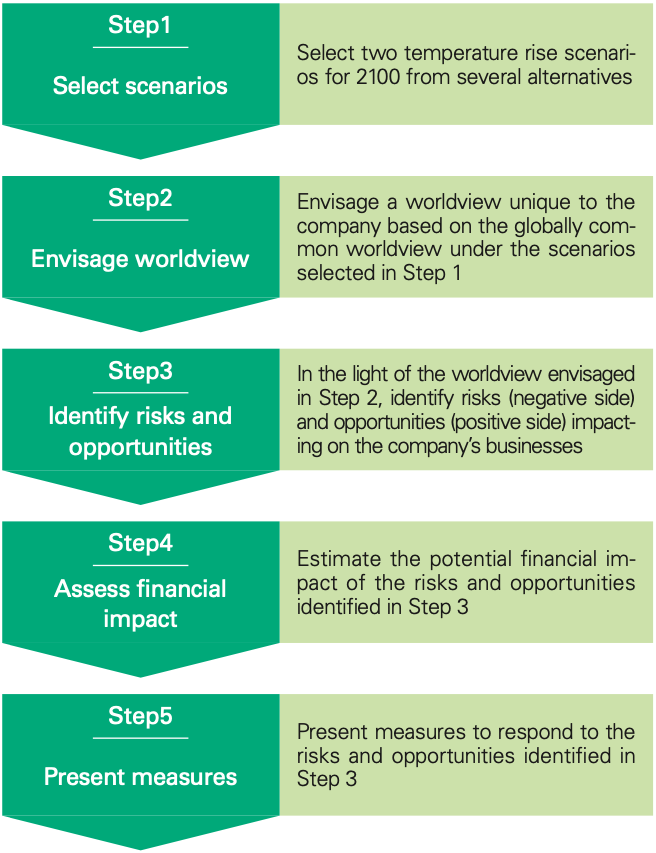
1.5℃ rise scenario(NZE, RCP1.9)
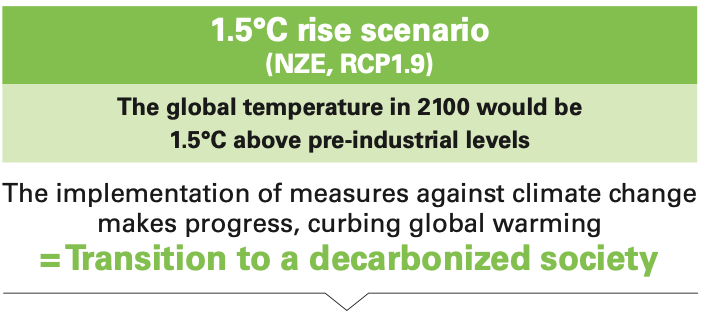
Envisaged impact on businesses
All businesses
- Introduction of carbon tax
- Tighter decarbonization regulations, heightened awareness of decarbonization
- Restrictions on the movement of people and goods
- Tighter regulations for measurement, tracking, and reporting of environmental initiatives
- Increased demand for energy-saving performance
- Changes in reputation among customers/investors
- Improvement of efficiency of production and logistics processes
- Increased demand for assistance with productivity improvements across entire value chain
Positioning Business
- Growing demand for low-carbon/decarbonization in construction, surveying, and agricultural sectors
- Progress in high-precision, efficient agricultural and construction solutions
- Advancement of next-generation technologies
Eye Care Business
None
4℃ rise scenario(STEPS, RCP6.0/RCP8.5)
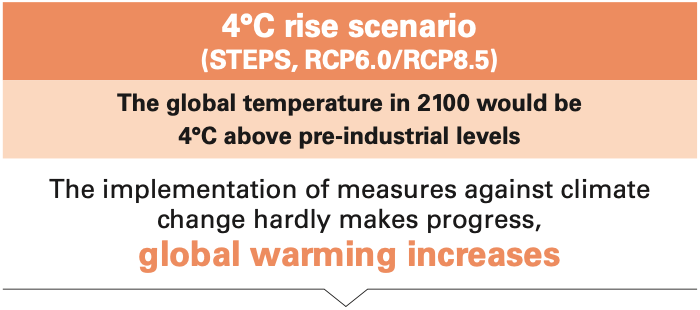
Envisaged impact on businesses
All businesses
- Increased severity of extreme weather events (larger-scale typhoons, hurricanes, etc.)
- Rising temperatures, and increased incidence of extreme weather events Positioning
Positioning Business
- Increased severity of extreme weather events (larger-scale typhoons, hurricanes, etc.)
- Changes in precipitation/weather patterns
- Increased demand for products and services for disaster recovery
Eye Care Business
- Higher incidence of eye diseases due to climate change
- Increase in near-sighted people due to longer hours of indoor living
Climate-related risks and opportunities under 1.5°C scenario
Climate-related risks
| Category | Envisaged impact on business | Applicable Segment |
||
|---|---|---|---|---|
| Transition risk | Policy and Legal | Introduction of carbon tax | Increased operating costs, such as procurement and transport costs, due to introduction of carbon tax | Company-wide |
| Decline in price competitiveness of products if costs resulting from introduction of carbon tax are passed through to product prices, resulting in reduction of market share | Company-wide | |||
| Tightening of decarbonization regulations, heightened awareness of decarbonization | Increased energy costs if restrictions on thermal power generation using fossil fuels are tightened | Company-wide | ||
| Costs to update to alternative equipment if use of fossil fuels is restricted | Company-wide | |||
| Imposition of fines and penalties and even suspension of operations if unable to respond to tighter carbon-related regulations | Company-wide | |||
| Restriction of movement of people and goods | In the movement of people and goods, possibility that the use of aircraft, which have large CO2 emissions, will be restricted, making lead times from product manufacture to sale longer, increasing operational costs and reducing revenue | Company-wide | ||
| Tightening of regulations for measurement, tracking and reporting of environmental initiatives | In addition to existing compliance requirements in the EU, increased emphasis on regulations for measurement, tracking and reporting of environmental initiatives, with a focus on climate change, and higher operational costs to address those regulations | Company-wide | ||
| Technology | Increased demands for energysaving performance | Demands for use of renewable energy and carbon neutral responses resulting from growing customer demands on suppliers for energysaving, and loss of opportunity and reduced revenue if unable to meet those demands | Company-wide | |
| Market and Reputation | Changes in reputation among customers/investors | Reduced revenue if unable to respond to customers’ demands for electrification | Company-wide | |
| Lower stock prices and reduced revenue due to reputational damage if decarbonization responses and information disclosures are inadequate | Company-wide | |||
| Reduced revenue caused by customers choosing products made in their own country or region with the promotion of local production for local consumption caused by heightened customer awareness of decarbonization | Company-wide | |||
Climate-related opportunities
| Category | Envisaged impact on business | Applicable Segment |
||
|---|---|---|---|---|
| Opportunities | Resource efficiency | Improvement of efficiency of production and logistics processes | Reduced CO2 emissions and costs related to packaging materials and transport from simplification of packaging for product shipment | Company-wide |
| Lower carbon taxes and energy costs in future due to efficiency improvements and energy-saving activities in production processes and logistics | Company-wide | |||
| Reduced CO2 emissions and costs by reducing energy consumption through switch to LED lighting, effective lighting control, repairs of buildings, and replacement of air conditioning equipment | Company-wide | |||
| Products and services | Increased demand for assistance with productivity improvements across entire value chain | Higher demand for GHG emissions reductions across customers’ entire value chains and increased sales of the Company products to meet that demand, against the background of energy reduction and efficiency improvement needs in the healthcare, agriculture, and construction sectors | Company-wide | |
| Market | Higher demand for lowcarbon/ decarbonization in construction, measurement, and farming sectors | Increased revenue from construction machinery that contributes to low/zero-carbon efforts in construction market and, by extension, IT construction solutions | Positioning Business | |
| Increased revenue from farming machinery that contributes to low/zero-carbon efforts in agricultural market and, by extension, auto steering systems for farming machinery | Positioning Business | |||
| Progress in highprecision, efficient farming and construction solutions | Potential for increased demand for the Company’s farming automation systems if restrictions on use of fossil fuels lead to advancement of large-scale cultivation of crops that can be used as raw materials for bioethanol such as sugar cane and maize | Positioning Business | ||
| Technology | Advancement of nextgeneration technologies | Expansion of market and increased revenue with advancement of hybridization, electrification, and IT conversion of construction machinery | Positioning Business | |
| Expansion of market and increased revenue with advancement of hybridization and electrification of farming machinery and of smart agriculture | Positioning Business | |||
| Increased demand for products and services that address climate change | Increased revenue and higher share price due to higher evaluation from customers/investors of technologies and business expansion that contribute to the realization of a carbon-free society | Positioning Business | ||
Climate-related risks and opportunities under 4°C scenario
Climate-related risks
| Category | Envisaged impact on business | Applicable Segment |
||
|---|---|---|---|---|
| Physical risk | Acute | Increased severity of extreme weather events (larger-scale typhoons and hurricanes) | Amid increased severity and incidence of extreme weather events such as torrential rain and floods, deterioration of financial situation due to disaster-related losses, including reduced revenue and higher costs caused by suspension of production and shipment of the Company plants affected by such disasters | Company-wide |
| Reduced revenue caused by decline in customers’ financial leeway when crop productivity declines and infrastructure construction projects are interrupted as a result of extreme weather events caused by climate change | Positioning Business | |||
| Rising temperatures, increased incidence of extreme weather events | Reduced revenue due to suspension of distribution, sales, repair services, etc. in manufacturing and sale regions around the world resulting from extreme weather events caused by climate change | Company-wide | ||
| Chronic | Rising temperatures | Rising costs for stringent temperature management in production processes of precision equipment | Company-wide | |
| Changes in precipitation patterns and weather patterns | Reduced demand for products caused by higher farm production costs in drought-prone regions and by decline in land under cultivation in regions with high water stress | Positioning Business | ||
Climate-related opportunities
| Category | Envisaged impact on business | Applicable Segment |
||
|---|---|---|---|---|
| Opportunities | Market | Higher incidence of eye diseases due to climate change | Increased revenue from the Company’s eye examination equipment and surgical equipment with increase in incidence of eye diseases due to climate change | Eye Care Business |
| Increase in near-sighted population due to climate change | Increased revenue from the Company’s eye examination equipment due to further acceleration of near-sighted population as people spend more time indoors | Eye Care Business | ||
| Resilience | Increased demand for products and services that address disaster recovery and climate change | Increased revenue as high-precision, efficient farming solutions will enable ideal fertilization and irrigation after efficient evaluation measurement, making agricultural farming possible, even if progression of climate change causes a shift in land suitable for cultivation | Positioning Business | |
| Continued demand for products and services to respond to national land infrastructure resilience building, including roads, tunnels, bridges, embankments, and dams, disaster readiness and recovery, and climate change, and, simultaneously, increased demand for and revenue from construction with the Company’s products | Positioning Business | |||

